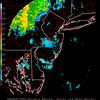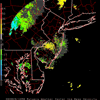Last night was interesting, to say the least. Surface winds were out of the SW early in the night, switching around to the East by morning. The upper level winds, however, were from the West – Northwest, which likely influenced the migration we see in the radar. Birds are seen taking off after sunset and continuing through just before sunrise this morning. Velocities were low, probably due to birds moving against the crosswinds at high altitude (the movement is from north to south, while the winds were mostly westerly).
So where are the birds? Well, warbler-wise they’re not in my backyard! Actually, there were several Am. Redstarts, a Canada, a Prairie and some Common Yellowthroats. “Small bird” diversity was low on my morning walk, although there were plenty of larger birds around (large flocks of Am. Robins, one huge flock (500+) of Common Grackles). This begs the question as to whether last night’s migration was primarily made up of larger migrants…I await reports from the field!
Good Birding


4 responses to “Vacuum or Birdblower?”
Do immature birds migrate earlier than their adult counterparts?
Last week i noticed an immature N. oriole trying to thwart the net over my fig trees. Since i rarely see orioles in my backyard, I’m assuming he is an early migrant. any thoughts?
Hello David,
>
> My name is Brian McAllister and I live up in the Adirondack Mountains of upstate NY. You’ve got a wonderful website, especially for “migration-watchers” like me.
I just want to quickly mention that lastnight(8/28 PM and 29 AM) I listened to probably hundreds, if not thousands,of thrush species flying south overhead. I had to rush back inside and listen to M. O’ Brien’s “Flight Calls” CD for indentification. Hard to
pin-point but I would say lots of gray-checked and hermit as well as lots of warblers.
Keep up the good work!
Cool! This evening I had a small feeding flock of mostly Carolina Chickadees, Tufted Titmice, a Baltimore Oriole (adult male), American Redstarts and a single Worm-eating Warbler. Another small group had N. Cardinals and a Rose-breasted Grosbeak.
As for the immatures moving at different times, I know there are migration timing differences based on both age and sex in many species, but I don’t know specifics for Baltimore Oriole. I have been seeing BAOR’s almost daily for the past three weeks, so I think it’s probably correct timing (but that’s just a gut feeling).
Cheers
David
Chris Vogel’s post to Jerseybirds:
A few good birds around Cape Island today were:
1 Continuing American Avocet- Meadows
1 Adult Caspian Tern- Meadows
1 Buff-breasted Sandpiper continues at the Meadows
2 Long-billed Dowitchers were still there as well
Soras, lots and lots of Stilt Sandpipers, and a host
of Lesser Yellowlegs were also still at ths South Cape
May Meadows.
No Godwits were in the neighborhood while I was
looking today.
Of note around Higbee’s and Hidden Valley, along with
a couple of hundred Eastern Kingbirds, over 40
Baltimore Orioles, Bobolinks, and plenty of Ovenbirds,
Northern Waterthrushes, Redtsarts, Black and Whites
were, among others:
1 Yellow-bellied Flycatcher that I saw, and I hear
there were one or two more
1 Mourning Warbler- SE corner of the first field at
Hidden Valley. Good looking, yellow eye-ringed first
fall bird.
Cheers
CJV
Cape May Nj